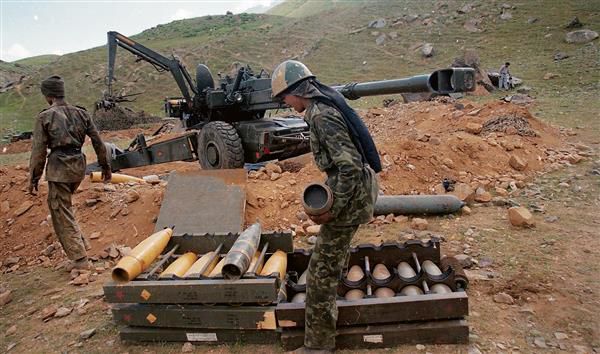Kargil War showcased heroism, exposed lapses
MANY articles and essays have been written about the 25-year-old Kargil War over the past few weeks — on how India’s politico-intelligence and military leadership were taken completely by surprise by the wily Gen Pervez Musharraf’s adventurism in the high Himalayas. Even then, India’s military response was measured, and steps were taken on those steep slopes after plans were adopted with due calculation by India’s politico-military leadership. And if India’s elite today appear more reassured, it is because of what our bravehearts achieved against insurmountable odds in those battles along the Line of Control (LoC).
Briefly put, the Kargil conflict will be remembered first for the fighting spirit, patriotism and dogged determination of the Indian Army that led to the eviction of Pakistani intruders. Secondly, it exposed the sheer incompetence of India’s intelligence agencies, which kept shifting the blame onto the military brass. The Army’s job was not to collect information about the enemy’s actions but to act on the inputs provided to it. Thirdly, as India’s first televised war — which brought the battlefield into our living rooms — it created interest across India in matters military. But, above all else, the conflict gave sanctity to the LoC — as a de facto border — the contours of which Pakistan had set out to contest.
In the aftermath of the conflict, many books were published that should be read to understand why and how that conflict was fought. Apart from Gen VP Malik’s Kargil: From Surprise to Victory (2006), three others, in particular, need to be recalled. Gen Malik was the Army Chief during the 1999 war. In a country where the Ministry of Defence is struggling with what should be published, his account of that conflict is a must-read for soldiers and scribes.
Soldier-turned-politician Capt Amarinder Singh has written a valuable book titled A Ridge Too Far: War in the Kargil Heights (2001). It is a blow-by-blow account of the 10 infantry battalions that fought for the Kargil heights and were later honoured for their distinguished service by the Army Chief. The book goes into virtually every detail of the battles that were fought by the Indian soldiers against severe odds.
India has, since Independence, fought several big and small wars. And while the Army had a high ratio of officers-to-men killed in battle (1:24), this rose in the Kargil conflict to one officer killed for every 16 soldiers who died in the battles for the icy heights, from Tiger Hill to Tololing.
Capt Amarinder’s book is a salute to the quiet resolve of the Indian soldier. What more can a country ask from its men at arms than to die unquestioningly, sometimes even to shield the blunders of our civil-military leaders?
In his book, Kargil: Blood on the Snow (2002), Maj Gen Ashok Kalyan Verma, an infantry officer, has provided a historical analysis of what happened over those weeks, as India’s political leaders were hopelessly waffling while its soldiers methodically planned a response that exposed Pakistan’s betrayal of the agreed status on the LoC. More importantly, this book affirms, with some historical detail, that Pakistan’s military misadventure in Kargil was rooted in its desire to strengthen its hold on the northern areas of J&K and claim the Siachen Glacier, just as the British Commander in Chief of Pakistan in 1948, Gen Sir Douglas Gracey, had recommended that “if India is not to be allowed to sit on the doorsteps of Pakistan to rear and to flank… it is imperative that the Indian Army is not allowed to advance beyond the general line Uri-Poonch-Naushera.”
Another revelation made by the author is that the Indian Air Force (IAF) was initially reluctant to join in the operation because of the unsuitability of its aircraft for such tasks, but it was convinced by Gen Malik that ground operations had to be supported by the Air Force. We do know that the non-use of the IAF during the India-China conflict in 1962 is still a contentious issue for the Army and the Air Force.
But what the Kargil conflict highlighted was that Pakistan’s Generals could not only put together bold plans but were also willing to try them out. The same cannot be said about India’s military commanders. The reason for that lies in the culture of playing safe and the no-mistake syndrome that has come to dominate the Army over the past many years. The author dwells on this in detail and is critical of the damage that this has already done to the Indian Army. In his words, “this is perhaps the single most negative shortcoming of the Army today.”
Kargil: The Tables Turned (2001) — edited by Maj Gen Ashok Krishna (retd) and the late PR Chari — underscores why the absence of a national consciousness on security matters resulted in Indian soldiers paying with their lives for the decades of neglect, which left them ill-equipped and created a defensive mindset among India’s military brass. Besides, the total lack of assessment of our enemy’s capabilities hardly comes as a surprise. As our troops were pushed into battle with outdated maps, improper equipment and clothing and inefficient weapons, the shocking state of logistic support for troops on the frontlines leaves one appalled at the level of neglect of our armed forces. All past governments in Delhi are to blame for this neglect.
The book comprehensively covers each battle of the Kargil conflict. It must be read to prevent the sorry state of affairs that was conspicuous through the initial stages of the conflict. The central question, however, is: will we ever learn the right lessons?









